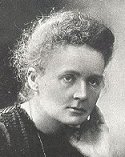| VIAS Encyclopedia provides a collection of tables and definitions commonly needed in science and engineering. |

|

Home  Science History Science History  Biographies Biographies  Marie Curie Marie Curie |
||||






|
||||
Marie Curie (1867 - 1934)
Maria Sklodowska-Curie (November 7, 1867 - July 4, 1934) was a pioneer in the early field of radiology and a two-time Nobel laureate. Born in Warsaw, Poland, her first years were sorrowful ones, marked by the death of her sister and, four years later, her mother. She was notable for her diligent work ethic, neglecting even food and sleep to study. After graduating from high school, she suffered a mental breakdown for a year. Due to her gender, she was not allowed admission into any Russian or Polish universities so she worked as a governess for several years. Eventually, with the monetary assistance of her elder sister, she moved to Paris and studied chemistry and physics at the Sorbonne, where she became the first woman to teach. At the Sorbonne she met and married another instructor, Pierre Curie. Together they studied radioactive materials, particularly the uranium ore pitchblende, which had the curious property of being more radioactive than the uranium extracted from it. By 1898 they deduced a logical explanation: that the pitchblende contained traces of some unknown radioactive component which was far more radioactive than uranium; thus on December 26th Marie Curie announced the existence of this new substance. Over several years of unceasing labour they refined several tons of pitchblende, progressively concentrating the radioactive components, and eventually isolated initially the chloride salts (refining radium chloride on April 20, 1902) and then two new chemical elements. The first they named polonium after Marie's native country, and the other was named radium from its intense radioactivity. Together with Pierre Curie and Henri Becquerel, she was awarded the Nobel Prize in Physics, 1903. Eight years later, she received the Nobel Prize in Chemistry, 1911. She was the first person to win or share two Nobel Prizes. She is one of only two people who has been awarded a Nobel Prize in two different fields, the other being Linus Pauling. In her later years, she was disappointed by the myriad of physicians and makers of cosmetics who used radioactive material without precautions. Her death near Sallanches, France in 1934 was from leukemia, almost certainly due to her massive exposure to radiation in her work.
|
||||
Home  Science History Science History  Biographies Biographies  Marie Curie Marie Curie |
||||
Last Update: 2010-12-14


